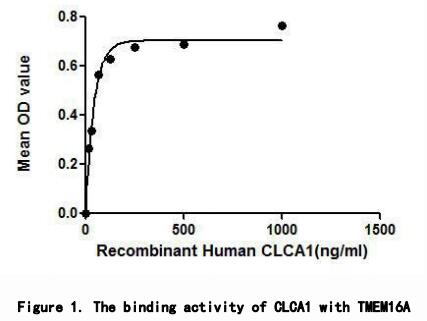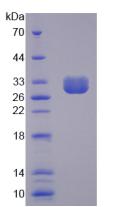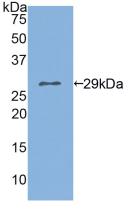Active Chloride Channel Accessory 1 (CLCA1) 

CaCC1; CLCRG1; Chloride Channel,Calcium Activated,Family Member 1; Calcium-activated chloride channel protein 1
- UOM
- FOB US$ 320.00 US$ 800.00 US$ 1,600.00 US$ 4,800.00 US$ 12,000.00
- Quantity
Overview
Properties
- Product No.APG669Hu01
- Organism SpeciesHomo sapiens (Human) Same name, Different species.
- ApplicationsCell culture; Activity Assays.
Research use only - DownloadInstruction Manual
- CategorySignal transduction
- Buffer FormulationPBS, pH7.4, containing 0.01% SKL, 1mM DTT, 5% Trehalose and Proclin300.
- Traits Freeze-dried powder, Purity > 97%
- Isoelectric Point7.1
Sign into your account
Share a new citation as an author
Upload your experimental result
Review

Contact us
Please fill in the blank.
Activity test

CLCA1 (Calcium-activated chloride channel regulator 1) is a member of the calcium sensitive chloride conductance protein family. This protein is expressed as a precursor protein that is processed into two cell-surface-associated subunits. It has been reported that CLCA1 activates calcium-dependent chloride channel through the interaction with TMEM16A (anoctamin-1). Besides, there exits similarities between human and mouse TMEM16A in amino acid sequence with the identity of 89.66%. Thus, a functional ELISA assay was conducted to detect the association of recombinant human CLCA1 with recombinant mouse TMEM16A. Briefly, CLCA1 were diluted serially in PBS with 0.01%BSA (pH 7.4). Duplicate samples of 100uL were then transferred to TMEM16A-coated microtiter wells and incubated for 2h at 37°C. Wells were washed with PBST and incubated for 1h with anti-CLCA1 pAb, then aspirated and washed 3 times. After incubation with HRP labelled secondary antibody, wells were aspirated and washed 3 times. With the addition of substrate solution, wells were incubated 15-25 minutes at 37°C. Finally, add 50µL stop solution to the wells and read at 450nm immediately. The binding activity of CLCA1 with TMEM16A was shown in Figure 1 and this effect was in a dose dependent manner.
Usage
Reconstitute in 20mM Tris, 150mM NaCl (pH8.0) to a concentration of 0.1-1.0 mg/mL. Do not vortex.
Storage
Avoid repeated freeze/thaw cycles. Store at 2-8°C for one month. Aliquot and store at -80°C for 12 months.
Stability
The thermal stability is described by the loss rate. The loss rate was determined by accelerated thermal degradation test, that is, incubate the protein at 37°C for 48h, and no obvious degradation and precipitation were observed. The loss rate is less than 5% within the expiration date under appropriate storage condition.
Increment services
-
 BCA Protein Quantification Kit
BCA Protein Quantification Kit
-
 Molecular Mass Marker for Protein
Molecular Mass Marker for Protein
-
 Monoclonal Antibody Customized Service
Monoclonal Antibody Customized Service
-
 Polyclonal Antibody Customized Service
Polyclonal Antibody Customized Service
-
 Protein Activity Test Experiment Service
Protein Activity Test Experiment Service
-
 Electrophoretic Mobility Shift Assay (EMSA) Experiment Service
Electrophoretic Mobility Shift Assay (EMSA) Experiment Service
-
 Buffer
Buffer
-
 Lentivirus Packaging Experiment Service
Lentivirus Packaging Experiment Service
-
 Adenovirus Packaging Experiment Service
Adenovirus Packaging Experiment Service
-
 Real Time PCR Experimental Service
Real Time PCR Experimental Service
-
 Spike RBD Protein (S-RBD)
Spike RBD Protein (S-RBD)
-
 Protein G
Protein G
-
 Protein A
Protein A
Citations
- CLCA1 suppresses colorectal cancer aggressiveness via inhibition of the Wnt/beta-catenin signaling pathwaypubmed:28974231








